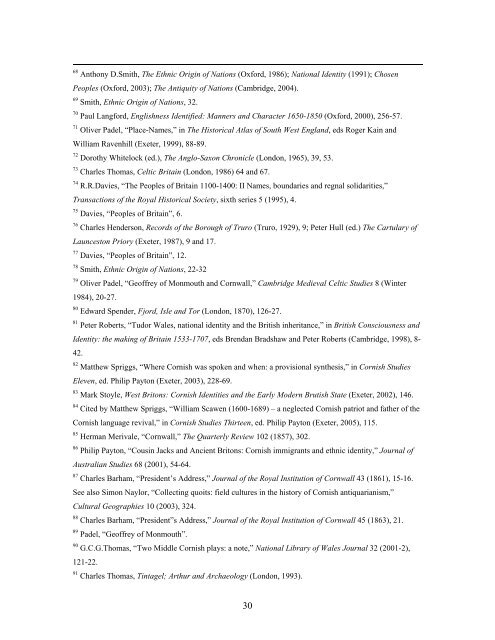Britishness, what it is and what it could be, is now high on both ...
Britishness, what it is and what it could be, is now high on both ...
Britishness, what it is and what it could be, is now high on both ...
You also want an ePaper? Increase the reach of your titles
YUMPU automatically turns print PDFs into web optimized ePapers that Google loves.
68<br />
Anth<strong>on</strong>y D.Sm<str<strong>on</strong>g>it</str<strong>on</strong>g>h, The Ethnic Origin of Nati<strong>on</strong>s (Oxford, 1986); Nati<strong>on</strong>al Ident<str<strong>on</strong>g>it</str<strong>on</strong>g>y (1991); Chosen<br />
Peoples (Oxford, 2003); The Antiqu<str<strong>on</strong>g>it</str<strong>on</strong>g>y of Nati<strong>on</strong>s (Cambridge, 2004).<br />
69<br />
Sm<str<strong>on</strong>g>it</str<strong>on</strong>g>h, Ethnic Origin of Nati<strong>on</strong>s, 32.<br />
70<br />
Paul Langford, Engl<str<strong>on</strong>g>is</str<strong>on</strong>g>hness Identified: Manners <str<strong>on</strong>g>and</str<strong>on</strong>g> Character 1650-1850 (Oxford, 2000), 256-57.<br />
71<br />
Oliver Padel, “Place-Names,” in The H<str<strong>on</strong>g>is</str<strong>on</strong>g>torical Atlas of South West Engl<str<strong>on</strong>g>and</str<strong>on</strong>g>, eds Roger Kain <str<strong>on</strong>g>and</str<strong>on</strong>g><br />
William Ravenhill (Exeter, 1999), 88-89.<br />
72<br />
Dorothy Wh<str<strong>on</strong>g>it</str<strong>on</strong>g>elock (ed.), The Anglo-Sax<strong>on</strong> Chr<strong>on</strong>icle (L<strong>on</strong>d<strong>on</strong>, 1965), 39, 53.<br />
73<br />
Charles Thomas, Celtic Br<str<strong>on</strong>g>it</str<strong>on</strong>g>ain (L<strong>on</strong>d<strong>on</strong>, 1986) 64 <str<strong>on</strong>g>and</str<strong>on</strong>g> 67.<br />
74<br />
R.R.Davies, “The Peoples of Br<str<strong>on</strong>g>it</str<strong>on</strong>g>ain 1100-1400: II Names, boundaries <str<strong>on</strong>g>and</str<strong>on</strong>g> regnal solidar<str<strong>on</strong>g>it</str<strong>on</strong>g>ies,”<br />
Transacti<strong>on</strong>s of the Royal H<str<strong>on</strong>g>is</str<strong>on</strong>g>torical Society, sixth series 5 (1995), 4.<br />
75<br />
Davies, “Peoples of Br<str<strong>on</strong>g>it</str<strong>on</strong>g>ain”, 6.<br />
76<br />
Charles Henders<strong>on</strong>, Records of the Borough of Truro (Truro, 1929), 9; Peter Hull (ed.) The Cartulary of<br />
Launcest<strong>on</strong> Priory (Exeter, 1987), 9 <str<strong>on</strong>g>and</str<strong>on</strong>g> 17.<br />
77<br />
Davies, “Peoples of Br<str<strong>on</strong>g>it</str<strong>on</strong>g>ain”, 12.<br />
78<br />
Sm<str<strong>on</strong>g>it</str<strong>on</strong>g>h, Ethnic Origin of Nati<strong>on</strong>s, 22-32<br />
79<br />
Oliver Padel, “Geoffrey of M<strong>on</strong>mouth <str<strong>on</strong>g>and</str<strong>on</strong>g> Cornwall,” Cambridge Medieval Celtic Studies 8 (Winter<br />
1984), 20-27.<br />
80<br />
Edward Spender, Fjord, Isle <str<strong>on</strong>g>and</str<strong>on</strong>g> Tor (L<strong>on</strong>d<strong>on</strong>, 1870), 126-27.<br />
81<br />
Peter Ro<str<strong>on</strong>g>be</str<strong>on</strong>g>rts, “Tudor Wales, nati<strong>on</strong>al ident<str<strong>on</strong>g>it</str<strong>on</strong>g>y <str<strong>on</strong>g>and</str<strong>on</strong>g> the Br<str<strong>on</strong>g>it</str<strong>on</strong>g><str<strong>on</strong>g>is</str<strong>on</strong>g>h inher<str<strong>on</strong>g>it</str<strong>on</strong>g>ance,” in Br<str<strong>on</strong>g>it</str<strong>on</strong>g><str<strong>on</strong>g>is</str<strong>on</strong>g>h C<strong>on</strong>sciousness <str<strong>on</strong>g>and</str<strong>on</strong>g><br />
Ident<str<strong>on</strong>g>it</str<strong>on</strong>g>y: the making of Br<str<strong>on</strong>g>it</str<strong>on</strong>g>ain 1533-1707, eds Brendan Bradshaw <str<strong>on</strong>g>and</str<strong>on</strong>g> Peter Ro<str<strong>on</strong>g>be</str<strong>on</strong>g>rts (Cambridge, 1998), 8-<br />
42.<br />
82<br />
Matthew Spriggs, “Where Corn<str<strong>on</strong>g>is</str<strong>on</strong>g>h was spoken <str<strong>on</strong>g>and</str<strong>on</strong>g> when: a prov<str<strong>on</strong>g>is</str<strong>on</strong>g>i<strong>on</strong>al synthes<str<strong>on</strong>g>is</str<strong>on</strong>g>,” in Corn<str<strong>on</strong>g>is</str<strong>on</strong>g>h Studies<br />
Eleven, ed. Philip Payt<strong>on</strong> (Exeter, 2003), 228-69.<br />
83<br />
Mark Stoyle, West Br<str<strong>on</strong>g>it</str<strong>on</strong>g><strong>on</strong>s: Corn<str<strong>on</strong>g>is</str<strong>on</strong>g>h Ident<str<strong>on</strong>g>it</str<strong>on</strong>g>ies <str<strong>on</strong>g>and</str<strong>on</strong>g> the Early Modern Brut<str<strong>on</strong>g>is</str<strong>on</strong>g>h State (Exeter, 2002), 146.<br />
84<br />
C<str<strong>on</strong>g>it</str<strong>on</strong>g>ed by Matthew Spriggs, “William Scawen (1600-1689) – a neglected Corn<str<strong>on</strong>g>is</str<strong>on</strong>g>h patriot <str<strong>on</strong>g>and</str<strong>on</strong>g> father of the<br />
Corn<str<strong>on</strong>g>is</str<strong>on</strong>g>h language revival,” in Corn<str<strong>on</strong>g>is</str<strong>on</strong>g>h Studies Thirteen, ed. Philip Payt<strong>on</strong> (Exeter, 2005), 115.<br />
85<br />
Herman Merivale, “Cornwall,” The Quarterly Review 102 (1857), 302.<br />
86<br />
Philip Payt<strong>on</strong>, “Cousin Jacks <str<strong>on</strong>g>and</str<strong>on</strong>g> Ancient Br<str<strong>on</strong>g>it</str<strong>on</strong>g><strong>on</strong>s: Corn<str<strong>on</strong>g>is</str<strong>on</strong>g>h immigrants <str<strong>on</strong>g>and</str<strong>on</strong>g> ethnic ident<str<strong>on</strong>g>it</str<strong>on</strong>g>y,” Journal of<br />
Australian Studies 68 (2001), 54-64.<br />
87<br />
Charles Barham, “President’s Address,” Journal of the Royal Inst<str<strong>on</strong>g>it</str<strong>on</strong>g>uti<strong>on</strong> of Cornwall 43 (1861), 15-16.<br />
See also Sim<strong>on</strong> Naylor, “Collecting quo<str<strong>on</strong>g>it</str<strong>on</strong>g>s: field cultures in the h<str<strong>on</strong>g>is</str<strong>on</strong>g>tory of Corn<str<strong>on</strong>g>is</str<strong>on</strong>g>h antiquarian<str<strong>on</strong>g>is</str<strong>on</strong>g>m,”<br />
Cultural Geographies 10 (2003), 324.<br />
88<br />
Charles Barham, “President”s Address,” Journal of the Royal Inst<str<strong>on</strong>g>it</str<strong>on</strong>g>uti<strong>on</strong> of Cornwall 45 (1863), 21.<br />
89<br />
Padel, “Geoffrey of M<strong>on</strong>mouth”.<br />
90<br />
G.C.G.Thomas, “Two Middle Corn<str<strong>on</strong>g>is</str<strong>on</strong>g>h plays: a note,” Nati<strong>on</strong>al Library of Wales Journal 32 (2001-2),<br />
121-22.<br />
91<br />
Charles Thomas, Tintagel; Arthur <str<strong>on</strong>g>and</str<strong>on</strong>g> Archaeology (L<strong>on</strong>d<strong>on</strong>, 1993).<br />
30
















